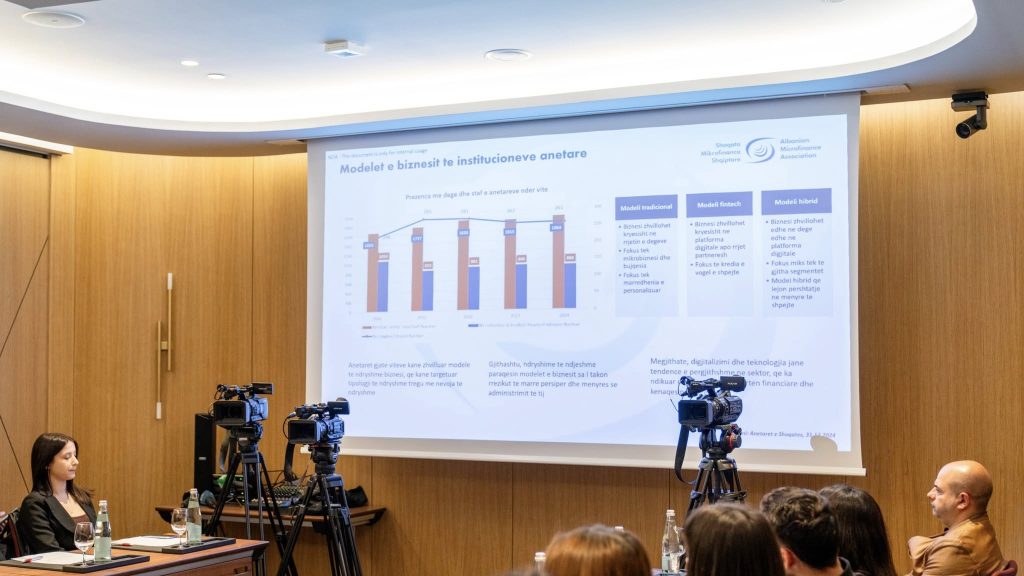Press Release Microfinance in Albania: Achievements, Challenges and Outlook for 2025
Press Release Microfinance in Albania: Achievements, Challenges and Outlook for 2025
by: AMA
March 21, 2025



Tirana, March 18, 2025 – The microfinance sector in Albania continued its growth and financial inclusion during 2024, strengthening its role as a key pillar of economic development. With significant achievements in digitalization, credit disbursement and financial access, the sector has proven resilient in the face of ongoing challenges. Looking ahead to 2025, stakeholders call for greater regulatory support and expanded financial inclusion mechanisms.
Key Achievements in 2024
Record Loan Disbursement: The sector disbursed around 100,000 new loans this year, increasing year-on-year, significantly supporting small and medium-sized businesses, agriculture, and underrepresented communities.
Financial Inclusion & Digital Expansion: 75,000 more clients benefited from micro-finance services, with a strong focus on digital access. Institutions continued to lead the digital transformation, offering full lending cycles on digital platforms and automated risk assessment systems.
Support for Women Entrepreneurs: Around 40% of clients were women, reflecting the sector’s commitment to their financial empowerment.
Job Creation & Economic Growth: For every loan provided to a startup, an average of three new jobs were created, underscoring the sector’s role in supporting entrepreneurship and employment.
Leader in Agricultural Finance: Microfinance remained the primary source of financing for agriculture, with a 31% increase in agricultural loans, despite the sector’s challenges.
Sustainable & ESG Initiatives: Albanian microfinance institutions continued to align with ESG standards, promoting responsible lending and sustainable economic activities.
Sector Challenges
Despite progress, the microfinance industry faces several challenges:
Regulatory & Legal Gap: The need for a new legal framework for non-bank financial institutions is vital to ensure transparency, risk management, and operational efficiency.
High Cost of Credit & Lack of Government Support: Unlike commercial banks, microfinance institutions do not have access to sovereign guarantee schemes, increasing the cost of funding and, consequently, the cost of credit for borrowers.
Financial Literacy & Informality: A large portion of potential clients continue to lack financial literacy, affecting their ability to access and manage credit effectively. Informality remains an obstacle to expanding financial access.
Digital Divide & Technological Barriers: Despite advances in digital transformation, the lack of integration of electronic identification and access to public databases limits the seamless provision of financial services.
Competition from Commercial Banks: Increased competition from commercial banks, particularly in SME financing, is putting pressure on microfinance institutions to further differentiate and innovate.
Outlook for 2025
Looking ahead, the microfinance sector aims to deepen its role in financial inclusion and economic development through:
Improving the Regulatory Framework: The sector seeks the adoption of a new law to improve licensing transparency, risk management practices, and fiscal treatment like that of banks.
Expanding Digitalization & Utilization of Big Data: Expanding digital platforms and integrating big data analytics will improve decision-making capabilities and risk assessment.
Improving Access to Low-Cost Finance: Efforts to secure lower-cost funds and inclusion in government financial support schemes will be essential.
Strengthening International Partnerships & Cooperation: Continued engagement with international financial networks and institutions will help bring in the global best practices and other financial opportunities.
Financial Education & Inclusion Initiatives: A particular focus will be on increasing financial literacy, especially for rural and disadvantaged communities.
The microfinance sector remains a core pillar of the financial landscape in Albania, addressing the needs of small businesses, farmers, and individuals who do not have access to traditional banking services. With continued innovation, regulatory support, and financial inclusion strategies, 2025 promises to be another year of growth and transformation.
About the Albanian Microfinance Association
The Albanian Microfinance Association represents the leading microfinance institutions in the country, committed to providing accessible financial solutions to underrepresented communities. For more information, visit www.ama.com.al or follow us on social media

